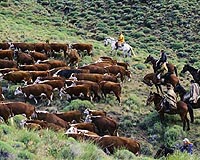 |
New York NY (SPX) Feb 12, 2010 The drivers of tropical deforestation have shifted in the early 21st century to hinge on growth of cities and the globalized agricultural trade, a new large-scale study concludes. The observations starkly reverse assumptions by some scientists that fast-growing urbanization and the efficiencies of global trade might eventually slow or reverse tropical deforestation. The study, which covers most of the world's tropical land area, appears in this week's early edition of the journal Nature Geoscience. Deforestation has been a rising concern in recent decades, especially with the recognition that it may exacerbate climate change. Studies in the late 20th century generally matched it with growing rural populations, as new roads were built into forests and land was cleared for subsistence agriculture. Since then, rural dwellers have been flooding into cities, seeking better living standards; 2009 was recorded as the first year in history when half of human lived in urban areas. Large industrial farms have, in turn, taken over rural areas and expanded further into remaining forests, in order to supply both domestic urban populations and growing international agricultural markets, the study suggests. "The main drivers of tropical deforestation have shifted from small-scale landholders to domestic and international markets that are distant from the forests," said lead author Ruth DeFries, a professor at the Earth Institute's Center for Environmental Research and Conservation. "One line of thinking was that concentrating people in cities would leave a lot more room for nature. But those people in cities and the rest of the world need to be fed. That creates a demand for industrial-scale clearing." DeFries and her colleagues analyzed remote-sensing images of forest cover across 41 nations in Latin America, Africa and Asia from 2000-2005, and combined these with population and economic trends. They showed that the highest forest losses were correlated with two factors: urban growth within countries; and, mainly in Asia, growth of agricultural exports to other countries. Rural population growth was not related. In recent years, tropical countries have been supplying growing amounts of palm oil, soybeans, sugar, meat and other processed products to distant markets abroad. Not all the products are used for food; palm oil and sugar in particular are also being converted into biofuels. Furthermore, said DeFries, as small farmers within tropical nations move away to become city dwellers, they may actually use more resources from the countryside, not less. This is because those living in cities have higher incomes-the reason most moved there to begin with-and thus tend to consume more processed foods and animal products. Pastures needed to produce meat, and large plantations and other facilities that turn out other products, in turn, require land. "Collectively, these results indicate a shift from state-run road building and colonization in the 1970s and 1980s to enterprise-driven deforestation," says the study. Hot spots of industrial-scale clearing include Brazil, Indonesia and Cambodia-countries that, unlike many others, still have considerable forests left to clear. The trend has not reached some forested parts of Latin America, such as Surinam or Guyana, which also have large tracts of remaining forest. Almost 60% of remaining forests occur in areas where net agricultural trade, percent of products exported, and urban growth are all relatively low. But as demand for products grows, these areas are likely to see increased pressure, the study says. According to projections by the United Nations, nearly all population growth in the next 40 years will take place in cities, and some two-thirds of people will live there by 2050. DeFries said that some initiatives aimed at halting deforestation need to be quickly shifted. For instance, some policies that focus on getting small landowners to conserve forests-a popular mechanism among governments and nonprofits at the moment-"may not be all that productive without a focus on large-scale clearing as well," she said. "Governments will have to look at policies that intensify yields on existing high-yield fields-not clear more land," she said. The other authors of the study are Columbia University ecologist Maria Uriarte; ecologist Thomas Rudel of Rutgers University; and Matthew Hansen of South Dakota State University.
Share This Article With Planet Earth
Related Links Earth Institute Farming Today - Suppliers and Technology
 Fernandez, farmers locked in Argentine row
Fernandez, farmers locked in Argentine rowBuenos Aires (UPI) Feb 11, 2009 Argentina's government has courted more controversy after a meeting between President Cristina Fernandez de Kirchner and farmers' representatives deteriorated into an angry war of words over who is to blame for higher beef prices. The government is already embroiled in an unprecedented row after its attempted use of Central Bank reserves to pay off Argentina's debt, which led to the rem ... read more |
|
| The content herein, unless otherwise known to be public domain, are Copyright 1995-2010 - SpaceDaily. AFP and UPI Wire Stories are copyright Agence France-Presse and United Press International. ESA Portal Reports are copyright European Space Agency. All NASA sourced material is public domain. Additional copyrights may apply in whole or part to other bona fide parties. Advertising does not imply endorsement,agreement or approval of any opinions, statements or information provided by SpaceDaily on any Web page published or hosted by SpaceDaily. Privacy Statement |